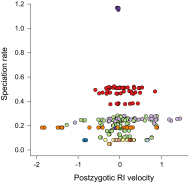Macroevolutionary speciation rates are decoupled from the evolution of intrinsic reproductive isolation in Drosophila and birds
- PMID: 24003144
- PMCID: PMC3780891
- DOI: 10.1073/pnas.1305529110
Macroevolutionary speciation rates are decoupled from the evolution of intrinsic reproductive isolation in Drosophila and birds
Abstract
The rate at which speciation occurs varies greatly among different kinds of organisms and is frequently assumed to result from species- or clade-specific factors that influence the rate at which populations acquire reproductive isolation. This premise leads to a fundamental prediction that has never been tested: Organisms that quickly evolve prezygotic or postzygotic reproductive isolation should have faster rates of speciation than organisms that slowly acquire reproductive isolation. We combined phylogenetic estimates of speciation rates from Drosophila and birds with a method for analyzing interspecific hybridization data to test whether the rate at which individual lineages evolve reproductive isolation predicts their macroevolutionary rate of species formation. We find that some lineages evolve reproductive isolation much more quickly than others, but this variation is decoupled from rates of speciation as measured on phylogenetic trees. For the clades examined here, reproductive isolation--especially intrinsic, postzygotic isolation--does not seem to be the rate-limiting control on macroevolutionary diversification dynamics. These results suggest that factors associated with intrinsic reproductive isolation may have less to do with the tremendous variation in species diversity across the evolutionary tree of life than is generally assumed.
Keywords: hybrid incompatibility; mechanism of speciation; speciation gene; species concept.
Conflict of interest statement
The authors declare no conflict of interest.
Figures




Similar articles
-
No link between population isolation and speciation rate in squamate reptiles.Proc Natl Acad Sci U S A. 2022 Jan 25;119(4):e2113388119. doi: 10.1073/pnas.2113388119. Proc Natl Acad Sci U S A. 2022. PMID: 35058358 Free PMC article.
-
Behavioural reproductive isolation and speciation in Drosophila.J Biosci. 2012 Jun;37(2):359-74. doi: 10.1007/s12038-012-9193-7. J Biosci. 2012. PMID: 22581340 Review.
-
The Rate of Evolution of Postmating-Prezygotic Reproductive Isolation in Drosophila.Mol Biol Evol. 2018 Feb 1;35(2):312-334. doi: 10.1093/molbev/msx271. Mol Biol Evol. 2018. PMID: 29048573 Free PMC article.
-
Minimal effects of latitude on present-day speciation rates in New World birds.Proc Biol Sci. 2015 Jun 22;282(1809):20142889. doi: 10.1098/rspb.2014.2889. Proc Biol Sci. 2015. PMID: 26019156 Free PMC article.
-
Moving Speciation Genetics Forward: Modern Techniques Build on Foundational Studies in Drosophila.Genetics. 2017 Nov;207(3):825-842. doi: 10.1534/genetics.116.187120. Genetics. 2017. PMID: 29097397 Free PMC article. Review.
Cited by
-
Tree of life reveals clock-like speciation and diversification.Mol Biol Evol. 2015 Apr;32(4):835-45. doi: 10.1093/molbev/msv037. Epub 2015 Mar 3. Mol Biol Evol. 2015. PMID: 25739733 Free PMC article.
-
No link between population isolation and speciation rate in squamate reptiles.Proc Natl Acad Sci U S A. 2022 Jan 25;119(4):e2113388119. doi: 10.1073/pnas.2113388119. Proc Natl Acad Sci U S A. 2022. PMID: 35058358 Free PMC article.
-
Rates of niche and phenotype evolution lag behind diversification in a temperate radiation.Proc Natl Acad Sci U S A. 2019 May 28;116(22):10874-10882. doi: 10.1073/pnas.1817999116. Epub 2019 May 13. Proc Natl Acad Sci U S A. 2019. PMID: 31085636 Free PMC article.
-
Temperature-Dependent Evolutionary Speed Shapes the Evolution of Biodiversity Patterns Across Tetrapod Radiations.Syst Biol. 2023 Jun 16;72(2):341-356. doi: 10.1093/sysbio/syac048. Syst Biol. 2023. PMID: 35809070 Free PMC article.
-
Mito-nuclear selection induces a trade-off between species ecological dominance and evolutionary lifespan.Nat Ecol Evol. 2022 Dec;6(12):1992-2002. doi: 10.1038/s41559-022-01901-0. Epub 2022 Oct 10. Nat Ecol Evol. 2022. PMID: 36216905
References
-
- Kisel Y, et al. Testing the link between population genetic differentiation and clade diversification in Costa Rican orchids. Evolution. 2012;66(10):3035–3052. - PubMed
-
- Coyne JA, Orr HA (2004) Speciation (Sinauer, Sunderland, MA)
-
- Rabosky DL, McCune AR. Reinventing species selection with molecular phylogenies. Trends Ecol Evol. 2010;25(2):68–74. - PubMed
-
- Jablonski D. Species selection: Theory and data. Annu Rev Ecol Evol Syst. 2008;39:501–524.
-
- Dobzhansky TH. Genetics and the Origin of Species. New York: Columbia Univ Press; 1937.
Publication types
MeSH terms
LinkOut - more resources
Full Text Sources
Other Literature Sources
Molecular Biology Databases

